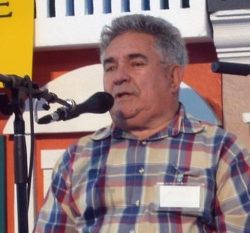Isleño Décimas
The traditional songs of the Spanish-speaking Isleños of St. Bernard Parish are known as décimas, traditionally a ten-verse satiric composition set to music.

The Archives of Cajun and Creole Folklore
Irvan Perez sings a décima, 1987.
While décimas, traditional, narrative songs, are not exclusive to Louisiana, the state has a rich tradition of these folksongs, particularly among its Isleño population in and around St. Bernard Parish. The word décima means “ten lines,” and the songs feature complex rhyme schemes in ten-line stanzas. Originating in sixteenth-century Spain, décimas were transported to Louisiana by the Canary Islanders known as Isleños who migrated to the region in the 1770s and 1780s. Modern Isleños continue to sing traditional décimas while developing new songs about their unique communities.
Although the form of the Isleño décima has become much less complex over time, the earliest Isleño décimas originally were sung, and perhaps also improvised, according to the traditional verse pattern. In 1891, Louisiana-French folklorist Alcée Fortier copied down a song sung by an aged Isleño, Pepe Martín, which fragmentarily attests to the ten-verse, metrically complex form. In contrast, modern décimas can be of any length.
The subject matter of Isleño décimas varies. Both traditional and modern versions of the songs are frequently amusing, satirical comments on local events and individuals. Many titles suggest the subject matter, perspective, and tone that characterize the décimas: for example, “Welfare Work,” “The Trappers’ War,” “Mosquitoes and High Water,” “Wila the Mule,” “The Hunting License,” “Conservation,” and “The Crab Fisherman’s Lament.” The subjects of décimas, whose activities, characteristics, attitudes, and foibles may be satirized in the songs, often pretend to be angry about what is said about them. However, in most cases, their protests are for show; they are secretly pleased at being recognized and remembered in the local repertoire of oral tradition.
Décimas are not always humorous or satirical; songs about survival in the face of hurricanes, floods, and other natural catastrophes reveal the strength and independence of the community. Contemporary décimas often reference environmental threats to the wetlands. Still, the tall tale remains the most memorable of the décima themes. For example, in “The Giant Trout,” Marcelino catches a trout so large that it blocks traffic on the road out of Shell Beach. When residents measure the fish, they find that it reaches to the other end of the Isleño settlements. In “Shrimp Fishing,” the ship is so gigantic that it is equipped with a telephone so the bow can talk with the stern; when the bow finally reaches its home port, the stern is still far out at sea in the Gulf of Mexico.
Irván Pérez, formerly the best-known décima singer in Louisiana’s Isleño community, remembered his father, Serafin, sitting around the kitchen table on Saturday nights with his friends. He and his fellow oral poets composed décimas, sometimes individually and sometimes as a group. Perhaps accompanied by a guitar, the group always interspersed their compositions with comments and laughter.
Louisiana décimas relate to other forms of oral poetry composed or improvised in Hispanic America, Spain, and Portugal, (e.g., corridos, gaucho poetry, Basque, Brazilian, and Portuguese improvised songs). The Isleños of St. Bernard Parish created their own highly distinctive Louisiana-Spanish community, however, and the unique qualities of their culture are reflected in the rich tradition of their décimas.
